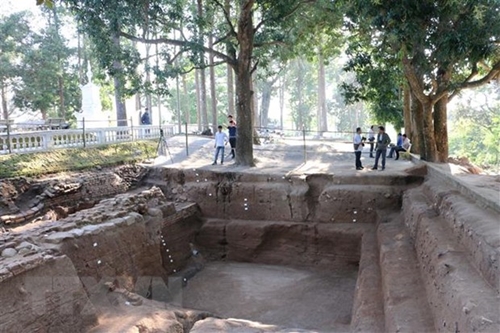May 01, 2022 | 21:29 (GMT+7)
More evidence supports recognition of Oc Eo archaeological relic as World Cultural Heritage site
New archaeological findings at the Oc Eo - Ba The and Nen Chua archaeological sites in the Mekong Delta provinces of An Giang and Kien Giang have set an important milestone in the research of the Oc Eo culture and provided reliable evidence and materials for the compilation of a dossier of the sites to seek recognition as a World Cultural Heritage site, a prominent archaeologist has said.
    |
 |
|
New archaeological findings at the Oc Eo - Ba The and Nen Chua archaeological sites in the Mekong Delta provinces of An Giang and Kien Giang have set an important milestone in the research of the Oc Eo culture. |
Assoc. Prof., Dr. Bui Van Liem, Editor-in-Chief of the Archaeology Journal and member of the National Cultural Heritage Council, added that the findings also serve as orientations for upcoming programs and research projects on the Oc Eo culture in the Mekong Delta in particular and across the ancient Phu Nam Kingdom at large.
The Prime Minister in 2015 assigned the Vietnam Academy of Social Science to launch a research project on the Oc Eo - Ba The and Nen Chua archaeological sites, with the goal of providing a trustworthy scientific foundation for the planning, conservation and building of a dossier on the relic site to submit to UNESCO for recognition as a World Cultural Heritage Site.
Between 2017 and 2020, archaeologists carried out large-scale excavations across an area of more than 16,000 sq.m. in Oc Eo field area and Ba The mountain, comprising eight sites.
Oc Eo culture was at its peak in the southern delta during the period from the first to seventh centuries.
The Oc Eo - Ba The national relic site in the Southern province of An Giang mostly covers Oc Eo Town, Thoai Son district. Parts of the site are over 2,000 years old.
The renowned relic was first discovered by French archaeologists in late 19th century. It is believed to have been a prosperous commercial port of the once-powerful Phu Nam Kingdom two millennia ago.
The relics in the region are extremely rich and diverse in terms of both style and material, giving an insight into the period’s religion, residencies, architecture, burial areas, ancient canals and waterways.
Source: VNA